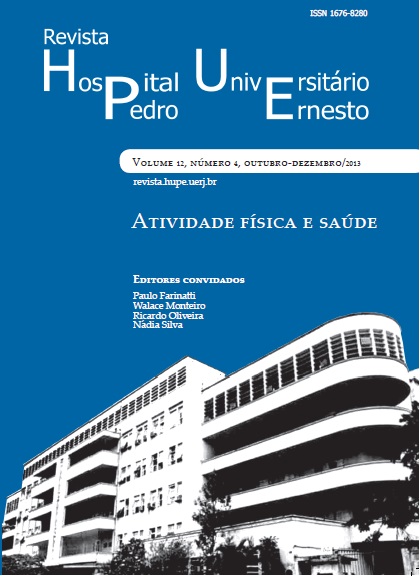Aplicação clínica do alongamento muscular: breve revisão
DOI:
https://doi.org/10.12957/rhupe.2013.8708Resumo
Exercícios de alongamento são usualmente recomendados em programas de treinamento físico. Nos últimos anos, os efeitos da hipomobilidade ou hipermobilidade na incidência de lesões vêm sendo investigados, bem como suas relações com doenças. O possível efeito do alongamento sobre o sistema cardiovascular também vem sendo alvo de interesse. Sendo assim, o objetivo desta breve revisão foi analisar os estudos que investigaram a aplicação clínica do alongamento muscular. Os artigos foram obtidos a partir de busca realizada nas principais bases de dados: National Library of Medicine (MEDLINE) (1966-2011), EMBASE (1974-2011), Cochrane Database of Systematic Reviews (Cochrane Reviews) (1993-2011), Literatura Latino-Americana e do Caribe em Ciências da Saúde (LILACS) (1982-2011), Physiotherapy Evidence Database (PEDro) e Scientific Eletronic Library Online (SciELO) (1997-2011); e foram originalmente publicados em língua inglesa e portuguesa. Não houve limite de data. Para cada base de dados foram utilizadas combinações de palavras‑título e seus respectivos sinônimos em inglês ou português. Verificou-se que hipomobilidade e hipermobilidade apresentam associação com problemas diversos de saúde, sendo importante analisar essas condições em avaliações físicas e funcionais. No primeiro caso, os exercícios de alongamento muscular deverão ser evitados, enquanto no segundo deveriam ser priorizados. Recentemente, estudos têm demonstrado que o alongamento muscular é capaz de produzir respostas cardiovasculares não negligenciáveis, mormente na frequência cardíaca, pressão arterial sistólica e diastólica, duplo produto e variabilidade da frequência cardíaca. Investigações nesse campo são necessárias, pois tais respostas podem ter implicações relevantes na segurança dos exercícios em determinados casos, mas também podem se associar a efeitos benéficos em longo prazo.
Descritores: Flexibilidade; Exercício; Aptidão física; Sistema cardiovascular; Saúde.
Revista HUPE, Rio de Janeiro, 2013;12(4):13-17
doi:10.12957/rhupe.2013.8708


